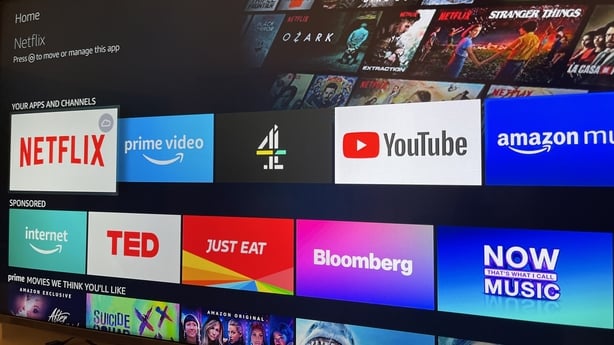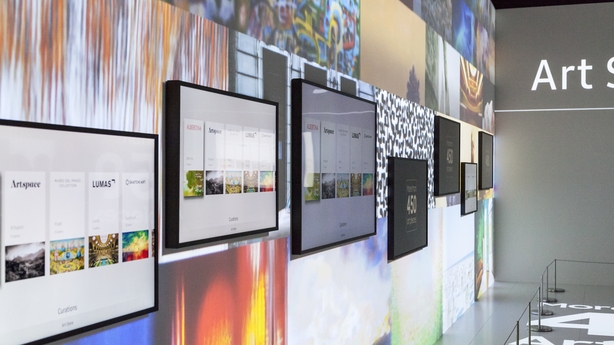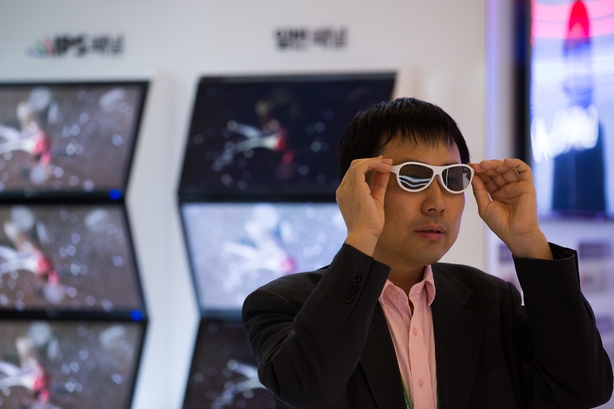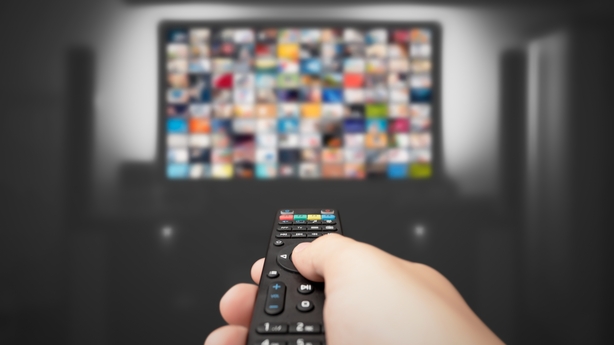The annual Consumer Electronics Show in Las Vegas is like tech Mecca. It sets the tone for the new gadgets that are going to grace shop shelves in the coming months.
At this year's event one of the hottest products was a new TV from LG – which could represent the future of home entertainment.
But, like all new tech, it’s not going to come cheap...
What are the big trends in TV technology?
We need your consent to load this rte-player contentWe use rte-player to manage extra content that can set cookies on your device and collect data about your activity. Please review their details and accept them to load the content.Manage Preferences
There are actually two – seemingly contradictory – trends in the world of TVs today.
One is to make our TV sets more vivid – and the other is to make them more discreet.
Manufacturers have long tried to boast the best picture quality – whether that’s through things like pixel density, contrast ratio or colour range.
At the moment that’s manifesting as a push towards brighter and brighter displays – and ones that perform well in all sorts of lighting conditions (even when sunlight is streaming in your window).
But making the picture quality better is also about making it darker.
You might notice if you’re watching a night-time scene in a film that the night sky isn’t actually black – it's maybe dark grey or even navy. That’s because the lights behind your TV’s picture are still on, and so the image it’s displaying can never be completely dark.
This is something manufacturers are trying to solve in a number of ways – with OLEDs and MiniLEDs the latest "solution".
They essentially allow for more precise darkening in parts of the screen – allowing for a better depth of colour.
At the moment at least, though, both technologies also a lot more expensive than regular LED TVs.
There’s a lot of talk about 4K and 8K too...

As people may remember, the switch from SD (standard definition) to HD (high definition) was a huge thing a decade or so ago.
But while HD was once sold as the latest and greatest thing, it became passé to manufacturers very quickly.
Now the focus is on 4K (or Ultra HD), which is four times the image quality of old-fashioned HD.
As you can guess, 8K is eight times the quality.
But the reality is that the vast, vast majority of what you’ll watch on your TV is going to be regular HD. That’s what all the main TV channels broadcast in (some are actually still in SD), and HD is the standard setting for streamers too.
You can subscribe to some channels that broadcast Ultra HD content – like sports or nature documentaries.
Some subscription services like Netflix also offer content in 4K; though to access it you'll have to pay for their premium membership.
You may also want to make sure you have a decent broadband connection with a high limit on how much you can download in a month, because those files are going to be huge.
As for 8K, you’re really going to struggle to find any content at all.
That might change in a few years but for now you’re not going to see much, if any, benefit if you pay extra for an 8K TV over a 4K one.
And, again, you’re going to be paying for it.
A check of Irish appliance retailers’ websites shows that the cheapest 8K TV on the market right now costs more than €2,000. Some go up to as much as €7,000.
You mentioned the trend towards making TVs more discreet – what do you mean by that?

The reality for most of us now is that the TV is the centre-piece of the living room – it's what we point our furniture at.
But they’re not the nicest looking appliance – especially when they’re switched off – and this is something manufacturers are increasingly trying to address.
A really good example of that is the Samsung Frame – which is a TV that’s designed to mimic a painting when not in use.
It manages that by having an incredibly thin screen, so it can hang flush on the wall just like a picture frame. It has a matte screen so it doesn’t shine like a normal TV screen would – and you can attach different frames to the surround.
And all of those things put together mean that, when you’re not using it, you can switch to 'art mode’ where it will display a picture – like a painting – that will look very like a regular picture.
Is there a catch?
Yes - more than one.
For a start, it costs a lot more than a standard TV. The price has come down a bit in the past year or so, but you’re still looking at a starting price of around a grand.
You also have to pay extra if you want different frames – and you have to pay if you want to use different pieces of art beyond the handful pre-loaded on the TV when you get it.
But there are more practical issues too.
You need a totally flat surface to hang it on – so if you’re one of the smart people who added your power point or other cabling behind the TV in order to hide all of the wires, it’s not going to work.
There’s actually only one cable coming from the TV that runs to a separate box.
It’s that box that does all of the heavy lifting, including connecting to power, connecting to any devices you have. But you’ll have to find a way to hide that one wire if you want to maintain the illusion of it being a painting.
It being flat on the wall might also limit where you can put it – because you won’t be able to angle it out to one side or another to suit the layout of your room.
And while you may think about hanging it up high – like you would a real picture or painting – that's actually a terrible viewing angle for a TV.
A TV should be at eye level as you sit down in front of it – you shouldn’t have to strain your neck to look up or down. But that kind of middle height probably isn’t where you’d hang a picture, so it will look odd.
And while the idea of having your TV look like a painting when you’re not using it is nice, it’s not very energy efficient.
The screen won't be using as much power as it would when you have a show on, but it’s still using more than it would if it was just switched off completely.
Are there any other ‘discreet’ TV options?

LG’s big TV reveal at this year’s CES is also pitched as a discreet advancement.
Its big selling point is that it’s actually a transparent screen – so, when it’s off, you can see right through it.
Even when it’s on you can have a semi-transparent image, or else you push a button and a background slides up so it looks like a regular TV.
And they’re saying that, not only will this be inconspicuous when it’s off, but you could even build it into a piece of furniture to better incorporate it into your home.
So maybe it would sit within a shelving unit – or even sit in front of a window without running the risk of spoiling the view.
But it’s worth bearing in mind that this was only unveiled a few weeks ago – and in the very controlled environment of an electronics trade show.
I’ll be interested to see how it actually functions in the real world – and how it holds up in different lighting conditions.
But the other big stumbling block is the fact that it is going to cost a lot of money.
LG didn’t give a price – but you can be sure it will be thousands and thousands of euro whenever it eventually makes its way to Irish shops.
But it may eventually become the norm...

More than likely – like all technology, what’s a premium feature now eventually becomes a standard, and the price falls down to something a bit more palatable.
A HD TV once would have cost thousands of euro – now you can get one for under €200.
If you want to be an early adopter, you have to accept that you’re not making an investment that you’ll get a return on.
What you buy now will almost certainly be available at a much lower cost in a year’s time.
There’s also a risk with early adoption that you back the wrong horse.
Just think about how TV companies were trying to convince us not so long ago that 3D TV would be the next big thing?
Or that a curved display would be the future?
And while there is a trend towards flatter and more discreet TVs, that is creating a new expense that you might not have had before.
Because in order to make the screens as flat as possible, certain components – like the speakers – have to be shrunk down – and that means that the sound quality isn’t as good.
So if you’re someone who struggles to hear dialogue in a film now, it may not be that your hearing is going.
There are actually a number of factors contributing to making it harder to hear what’s going on on your TV, but crap TV speakers are part of the problem.
And the only solution is to buy a soundbar or a surround sound system.
What about Smart TVs?

This is another feature that was once premium but is now the norm – in fact it’s probably hard to find a ‘dumb’ TV nowadays.
But the basic idea of a smart TV is that it can connect to your WiFi, and you can access apps directly through the TV.
So that might be Netflix or Disney+, or YouTube, or the RTÉ Player – It might also allow you to browse the internet – or you might be able to stream content from your phone onto your big screen.
In theory your smart TV might allow you to skip having a cable or satellite service, or even buying an Apple TV or an Amazon Firestick in order to access the streaming services.
That’s clearly a concern to some companies – like Sky, which last year released its own smart TV that doesn’t need a satellite link; instead you access your Sky service through your WiFi.
But there can be downsides to smart TVs - because sometimes TV manufacturers can do the hardware well, but they’re not good at building software.
That can lead to a user experience that is very frustrating.
And there have even been cases where manufacturers tried to use these smart features as another avenue to display ads to you.
There were some Samsung TVs where you might be looking through the programme guide, and a little banner ad would pop up at the bottom.
In other cases a smart TV might have the likes of Alexa or Google Assistant built in – which could be a problem if you’re uncomfortable with having devices listening out to what you’re saying.
There are usually ways of disabling these features in the settings – but if you’re buying a new TV, it’s worth finding out if you can avoid them altogether in the first place.







